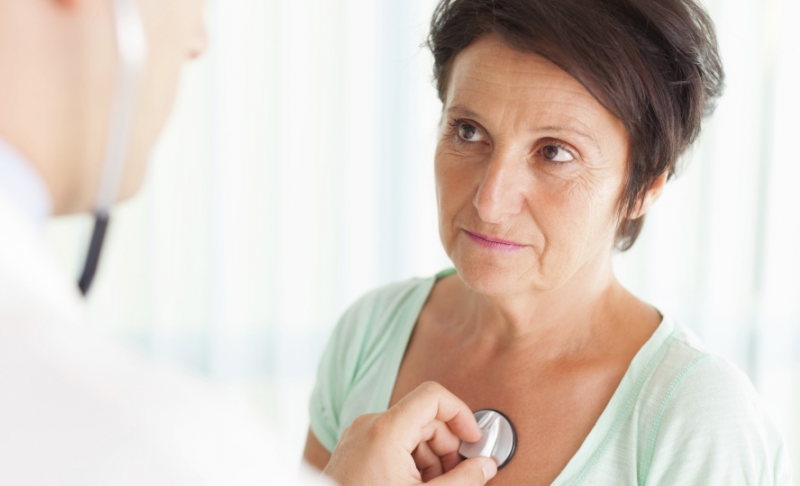Many doctors do not consider VVD as an independent disease. This is a chronic violation of the relationship of the central nervous system with the autonomic. Pathology has many symptoms, most often manifested in women. This article will detail the symptoms and treatment of vegetative-vascular dystonia in women.
Material Content:
- 1 Why do women develop vegetovascular dystonia
- 2 Signs and symptoms of the disease
- 3 Classification of types of pathology
- 4 Danger and manifestations during pregnancy
- 5 Methods of treatment of traditional medicine
- 6 Folk remedies for VVD
- 7 Specialized Exercise Complex
- 8 Diet and lifestyle with vegetovascular dystonia
- 9 What is the prevention
Why do women develop vegetovascular dystonia
Medical statistics say that most often vegetative-vascular dystonia affects women. In half the cases, the pathology manifests itself in childhood, but there are cases when the disease is diagnosed in adulthood against the background of psychosocial factors and health problems.
Typically, VSD in women occurs for the following reasons:
- Weighed down by heredity, because genetically VVD is transmitted exclusively through the female line. This category includes a disease that occurs during pregnancy, during the birth, and also infections that the fetus has passed in utero.
- Cardiac, vascular dysfunction. This pathology is the impetus for the formation of VVD.
- Mitochondrial pathology, which is transmitted genetically exclusively along the female line. These diseases are characterized by a lack of nutrients in tissues and organs.
- Hormonal changes that occur in women during adolescent development, pregnancy, menopause.
- The individuality of the body. This item includes stress resistance, excessive emotionality, instability of the psyche, increased anxiety, regular overstrain.
- Hypodynamia, which is a factor affecting the development of the IRR. Reduced motor activity reduces the immune system, makes a woman more susceptible to various infections.
- Infectious diseases that worsen the state of the autonomic nervous system.
- Osteochondrosis, pinched nerve endings. As a result, neuropathic symptoms occur.
- The presence of injuries that damage the nerve endings.
- Stress, which is a common cause of VSD.
- Allergies.
- The presence of bad habits.
- Climate change.
In addition, it has been observed that people living in large cities are more likely to experience vegetovascular dystonia, which is associated with unfavorable psychosocial, natural conditions.
Signs and symptoms of the disease
The autonomic nervous system is responsible for the functioning of the whole organism, ensures its adaptability to the external environment. It normalizes blood pressure, body temperature, muscle tone, heart rhythms.
Symptoms of VVD include the following conditions:
- panic attack;
- headache;
- decreased libido;
- insomnia;
- dizziness;
- disturbed sweating;
- sensation of hot flashes;
- increase, decrease in body temperature;
- unstable blood pressure;
- heart palpitations;
- pain in the sternum;
- lack of air;
- dyspnea;
- diarrhea;
- impaired urination.
It is possible to mix the symptoms of VVD of different types.
Classification of types of pathology
Vegetovascular dystonia has the following types:
- Hypertensive, accompanied by increased pulsation of the vessels of the brain. People suffering from this species are characterized by constipation, dilated pupils, tachycardia, high blood pressure, spasms of the skin.
- Hypotonic is the opposite of the hypertonic type; it occurs against the background of high activity of the autonomic nervous system, which is responsible for the functioning of the digestive organs, cardiovascular, and genitourinary system. The patient has diarrhea, low blood pressure, redness of the skin.
- Mixed, which is characterized by an alternation of symptoms of previous types of VSD.
- Cardinal. This species is characterized only by cardiac symptoms.
- Puberty. This species manifests itself in adolescents, occurs against the background of hormonal changes, psychological instability. Children, mainly, suffer from increased irritability, excessive sweating, heart palpitations, sudden mood swings, increased fear for life and health, causeless panic.
- Cephalogical. This VVD is characterized by damage to the cerebral vessels. As a result, a woman suffers from frequent pulsating headaches of mild and severe manifestations. Often there is dizziness, combined with nausea, vomiting.
- Vagotonic, arising against the background of brain pathology. The main symptoms relate to the respiratory system, digestion, manifested by nausea, loss of appetite, increased salivation, flatulence, sleep disturbance, obesity, edema, decreased performance.
VVD has diverse symptoms, a difficult task for a doctor is to find the cause that caused this imbalance.
On a note. Often, VVD is diagnosed if the doctor cannot determine exactly whether the symptomatology belongs to a specific disease.
Danger and manifestations during pregnancy
The manifestation of VVD during pregnancy is dangerous.
- When hypotonic, a woman quickly loses weight, the fetus suffers from hypoxia. As a result, there is a chance of having a baby with a low weight, weak immunity. The most dangerous disease in the initial period.
- Hypertensive VVD occurs with high blood pressure, late toxicosis, edema, headaches, panic attacks.This disease can cause uterine bleeding, placental abruption, increased tone of the uterus, the likelihood of miscarriage, premature birth.
The greatest danger for the unborn baby is caused by mixed VVD. To avoid its negative impact, a woman needs regular medical examination and timely treatment.
Methods of treatment of traditional medicine
The treatment of VVD is carried out by different groups of medicines, depending on the type of disease. Medicines are prescribed after the diagnosis.
Typically, patients are recommended the following groups of drugs:
- sedatives: valerian, Zelenin drops, Validol, Novopassit;
- vasodilator: Panangin, Asparkam, Vinpocetine;
- antidepressants: Coaxil, Amitriptyline;
- Nootropics: "Glycine", "Pantogam", "Piracetam";
- normalizing blood circulation: Cavinton, Oxybral;
- normalizing blood pressure: “Metoprolol”, “Anaprilin” - with high blood pressure, infusion of Rhodiola rosea, “Mesaton” - with low blood pressure;
- general strengthening: "Actovegin", "Anaprilin", "Riboxin";
- sleeping pills: "Zolpidem", "Donormil."
The appointment of the drug, its dosage and duration of treatment should be carried out by the doctor, based on the patient's condition and type of VVD.
Folk remedies for VVD
In conjunction with traditional medicine preparations for VVD, alternative methods are used. This is usually herbal medicine.
With vegetovascular dystonia, decoctions are prescribed, infusions from the following medicinal plants:
- peony root;
- lemon balm;
- thyme;
- motherwort;
- ginseng;
- hawthorn.
Important! Treatment with folk remedies must be agreed with the doctor. Many herbs give a powerful calming effect, which will be unsafe with hypotension. Plants often cause allergies.
To normalize the pressure, nettle is recommended, cranberries and viburnum will help get rid of the headache. Green tea with honey will be useful - for immunity, young potatoes with a peel - to strengthen the heart muscles.
Specialized Exercise Complex
You can fight with VVD using a specialized set of exercises compiled by a competent specialist. For patients with this disease, there is no single complex that helps in the fight against different types of dystonia. Nevertheless, there are general tips that will help people suffering from this pathology.
- classes begin with a warm-up, then there is a gradual increase in load, end with a stretch;
- should not focus on one sport, a combination of different activities is necessary;
- you cannot overwork, you must listen to your body;
- it is better to conduct some types of activities in the fresh air;
- to enhance the mood, you can use the player with your favorite music;
- professional, competitive classes are prohibited.
Note. For the development of a set of exercises, you can contact the LFK office, where they will also be taught how to perform them correctly.
To achieve the desired result, doctors recommend a combination of the following types of load:
- pool, unloading joints, relaxing and tonic at the same time;
- walking strengthens the muscles and musculoskeletal system;
- aerobics gives a positive charge of energy;
- the bicycle improves blood circulation, mood;
- contrast shower helps improve vascular tone, strengthens the immune system.
People suffering from VSD are not shown power sports.
Diet and lifestyle with vegetovascular dystonia
With VVD, a diet is indicated to alleviate the condition, which is prescribed based on the individual characteristics of the patient's body. Using proper nutrition, blood pressure is regulated, the work of internal organs improves, digestive disorders are eliminated, urine is better excreted. Also, proper nutrition strengthens the immune system, controls the functioning of blood vessels, heart.
Important! You can cope with a panic attack with water with sugar dissolved in it.
With a hypotonic type of VSD, coffee, strong tea, and dairy products will improve the condition. For hypertensives, legumes, cereals, dairy products, greens will be useful. It is important to limit the tea, coffee, salty. To improve heart function, a large use of bananas, nuts, raisins, honey is indicated. With impaired digestion, a rejection of salty, spicy, fatty, fried foods is necessary.
Maintaining a healthy lifestyle, regular daily routine, timely sleep, and activity is of particular importance in VVD. It is necessary to abandon bad habits. Drinking alcohol is important to minimize. Daily walks, massage, contrast shower, feasible physical activity can improve the patient's condition.
What is the prevention
Preventive measures will help minimize the frequency of manifestations of signs of VVD, normalize the state of the nervous system, and eliminate suspiciousness.
Prevention of this pathology includes:
- complete cessation of smoking, alcohol;
- proper nutrition;
- feasible physical activity;
- active lifestyle;
- mastery of relaxation techniques;
- massage;
- cold and hot shower;
- use of folk and traditional methods of treatment.
When diagnosed with VVD, a regular examination by a doctor is necessary, compliance with all its recommendations.
VVD is a complex of symptoms that significantly worsen a person’s condition. With competent medical supervision and the maintenance of the right lifestyle, you can ease your health and minimize the manifestation of symptoms.





















